People are probably running out of things to say about Erling Haaland.
And understandably so, too.
It’s been well-publicised that he is the youngest player to score 20 Champions League goals, and the fastest player to get that amount of goals in the competition’s history too.
On top of these records and a host of others, in Haaland’s short time at Borussia Dortmund so far he has amassed 40 goals in 47 games in all competitions and made nine assists.
To highlight just how good his finishing has been in this time period, his xG is 29.68, outperforming this total by 10.32.
Whilst Dortmund have faltered as a side this season, Haaland hasn’t and sits joint second with Andre Silva in the Bundesliga top scorers list behind, of course, Bayern Munich‘s Robert Lewandowski.
However, what Haaland is achieving is totally unprecedented.
The previous record holder for being the youngest player to hit 20 goals in the Champions League was a certain Kylian Mbappe, and Mbappe completed this feat 10 days before his 22nd birthday.
Haaland is still 20.
Even more impressive was that Haaland hit these goals in just 14 Champions League games.
The previous record was Harry Kane’s 20 in 24 games.
In short, Haaland is scoring goals at an alarming rate, and for a player of such a tender age, he is doing many things to suggest that his goalscoring isn’t going to slow down at any time.
This Erling Haaland tactical analysis and scout report will highlight what makes Haaland such a potent attacking force.
Erling Haaland Data Analysis
To understand Haaland’s ability as a forward, it’s important to look at his data in context.
Whilst we could look at it against other Bundesliga forwards, I’ve decided to take a larger sample size and compare his statistics from this season with strikers from Europe’s top five leagues – La Liga, Ligue 1, Bundesliga, Serie A, and the Premier League.
I have only included those who have played at least 1000 minutes this season.
Before we even talk about his pace, he has the frame of a target man, standing at 1.94m.
Whilst he is lean, Haaland will undoubtedly put on more muscle as he ages.
Maybe this will lead to a slight drop in his pace, but even if he were to lose that aspect of his game, he’s less likely to fade as a result as some quick strikers have done in the past.
This is partly due to his physical potential, among other aspects of his game.
Whilst he competes in a below-average amount of aerial duels, he wins an above-average 47.3% when ranked against the forwards in Europe’s top five.
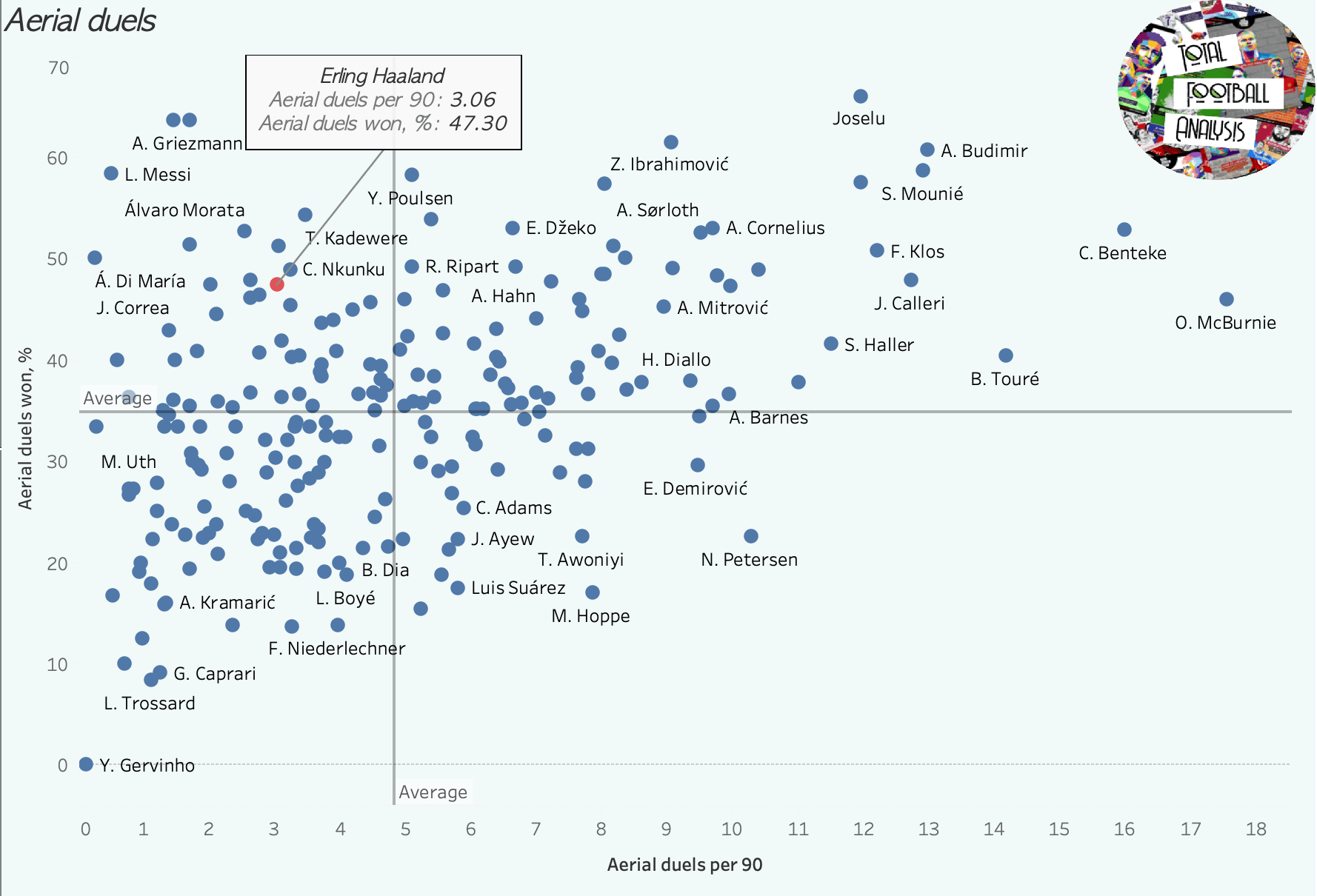
Before looking at how his actual goals and expected goals rank against his peers across Europe, we can look at whether he is getting a high amount of touches in the box per 90, and if he’s using these touches to get a high amount of shots away.
The answer is yes to both – emphatically so.
As we can see in the image below, Haaland ranks way above the average for both of these metrics, and whilst he ranks relatively similarly in terms of touches in the box to the likes of Cristiano Ronaldo, Robert Lewandowski, and Lionel Messi, these three players get a far higher number of shots away.
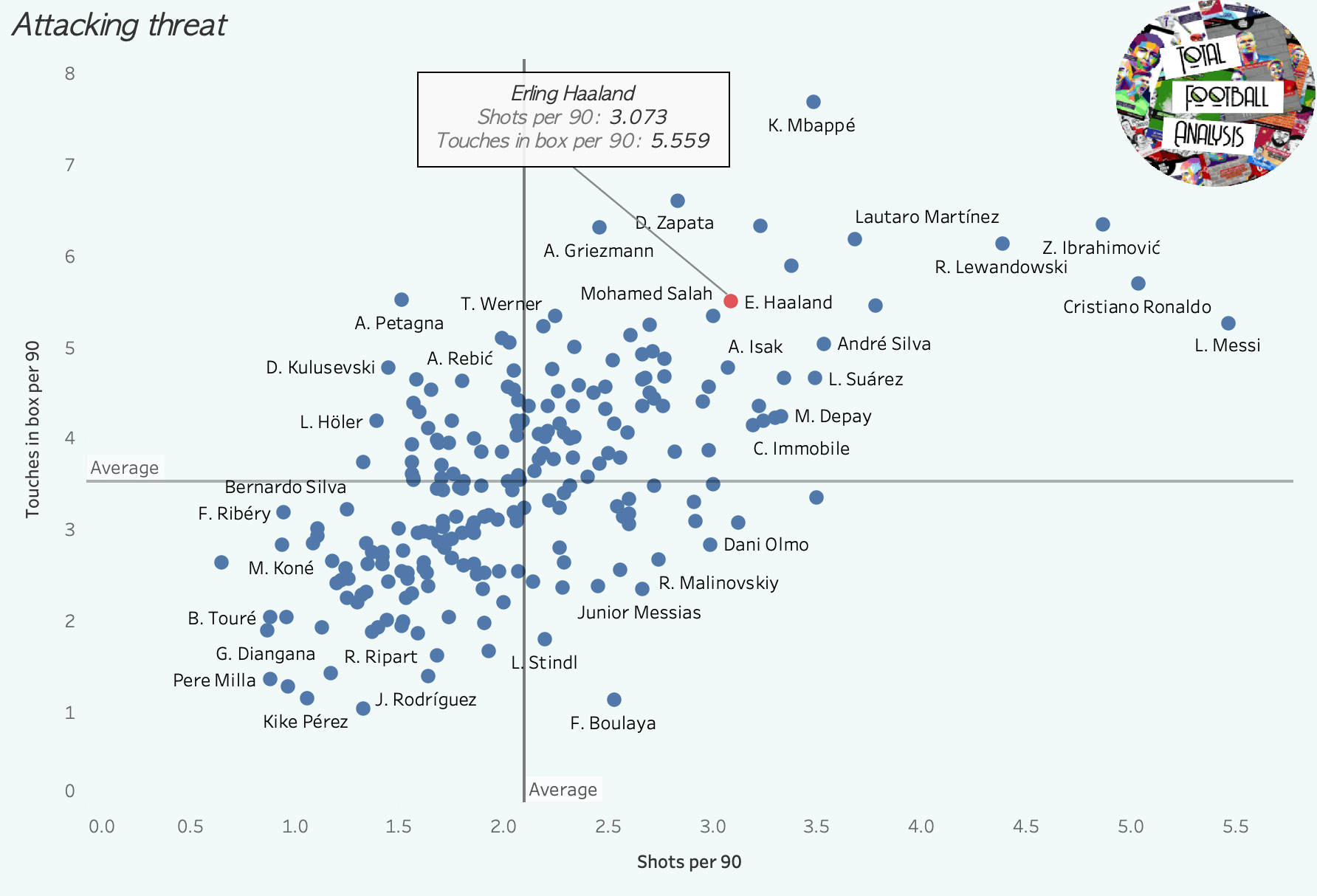
Both Robert Lewandowski and Zlatan Ibrahimovic are in a league of their own with both players ranking high for goals per 90 and xG per 90.
Lewandowski has the edge on goals, whilst Zlatan’s xG per 90 is higher.
However, when we look at the next batch of strikers in this graph, we can see that Haaland is in good company with the likes of Mbappe, Ronaldo, Andre Silva and Messi, to name a few.
However, Haaland actually has the lowest xG per 90 of the previously named players, yet his goals per 90 is higher.
We can look at this in one of two ways.
His overperformance of this metric could even out, although there’s nothing to suggest in his career thus far that this would be the case.
Or we can say that he is just an outstanding finisher, who is scoring chances that other forwards might not.
The sensible bet would be to say it’s the latter of the two options.
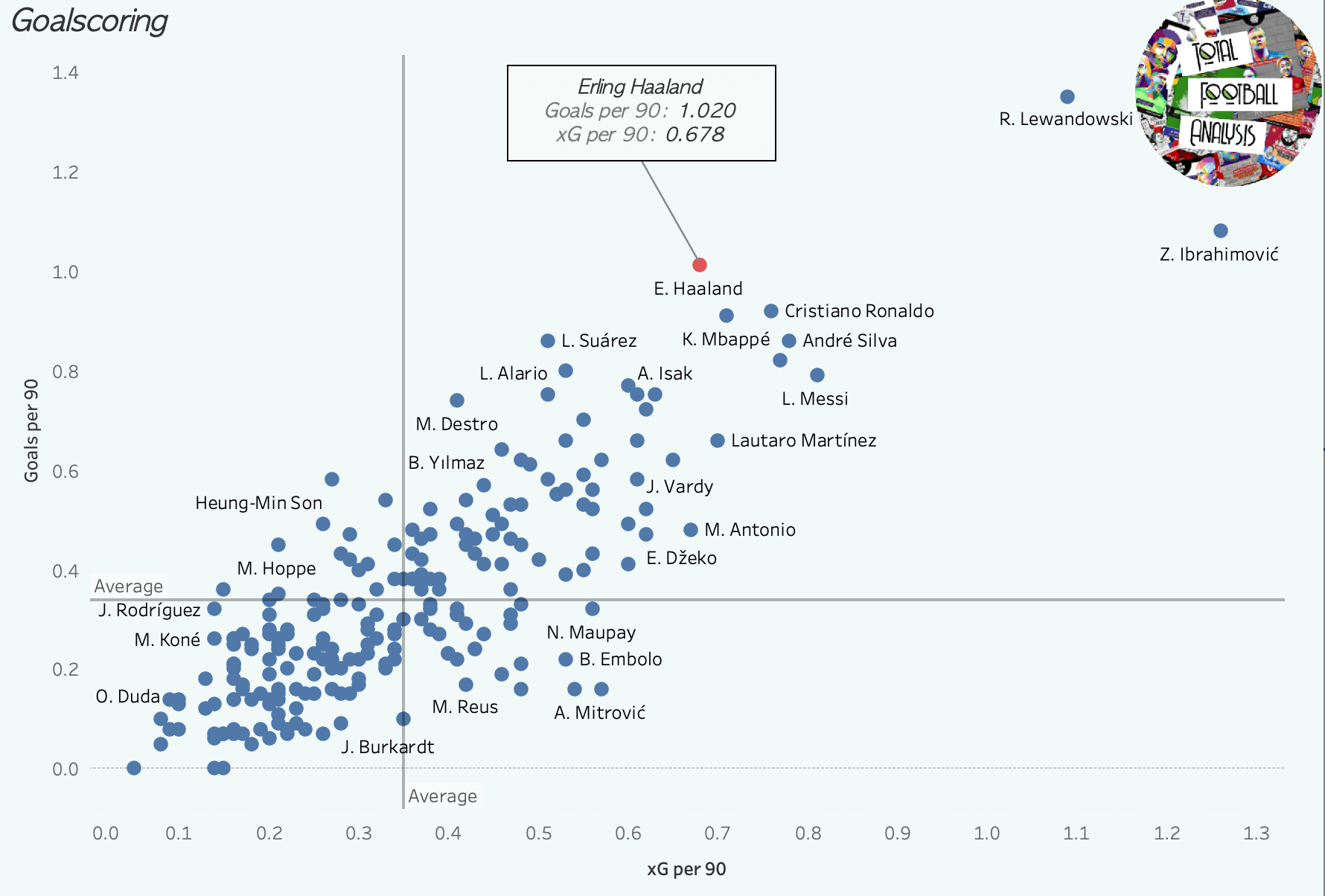
Erling Haaland Finishing
His goalscoring exploits then, are seemingly a good place to start.
Just how is Haaland so potent in front of goal?
We can begin to build a picture by looking at his shot map from this season.
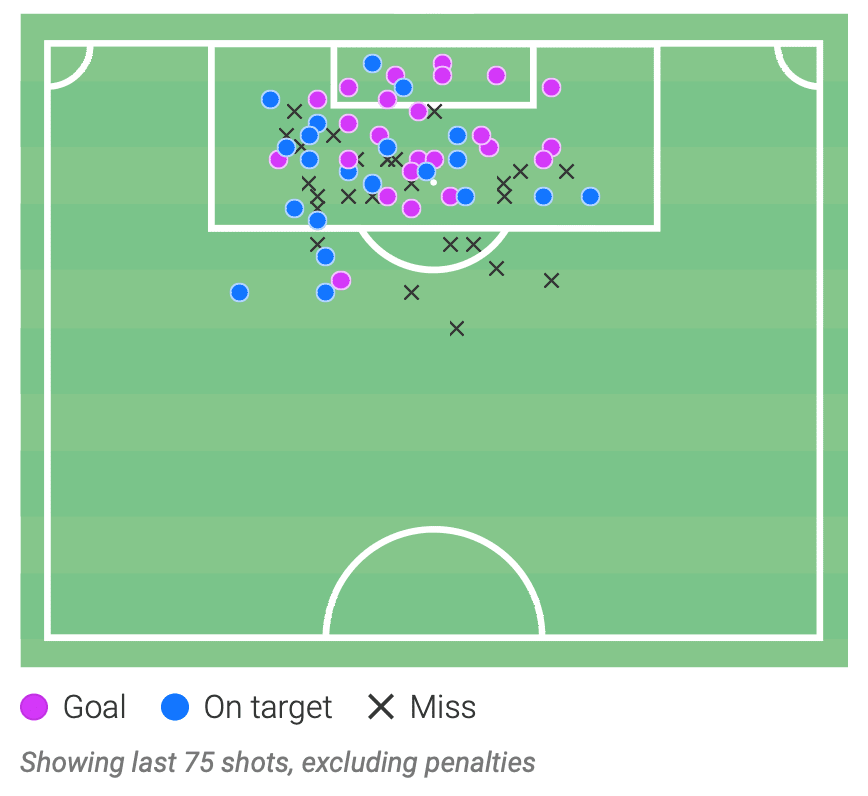
There is a clear preference for shooting from the left side of the pitch.
In fact most of his goals come from his preferred left foot.
If you wanted to find a goal from his right foot you’d have to go back to the beginning of November.
It’s pretty difficult to find any holes in his game when looking at this map, because he is not only hitting the target at such a high percentage, but so many of these shots are going in as well.
If we were to be picky, his accuracy from the central and right side area outside of the box is lacking, but having only taken six shots from this area, it’s not a big concern.
For Dortmund this season, Haaland is hitting the target with an astonishing 60.8% of his shots, and with 31 goals from 89 shots this campaign.
That’s a goal from every 2.87 shots.
To put this in context, Lewandowski has scored 37 goals in all competitions this season for Bayern, and is hitting the target with 46.5% of his shots.
His 37 goals have come in 121 shots, which is a goal in every 3.27 shots.
One reason Haaland is so potent is his ability to hit the target in different places but from the same location.
There are goals he has scored this season from very similar areas, but he has put the ball in different corners, near post and far post, lobbed the keeper, or smashed it down the middle of the goal.
His ability to finish so precisely is what sets him apart from so many forwards, but it is also him not having a tendency for a certain area of the goal.
The images below are just two examples, but as we can see Haaland’s position is nearly identical, as is the goalkeeper’s in each image, but in one he nestles the ball into the far post…
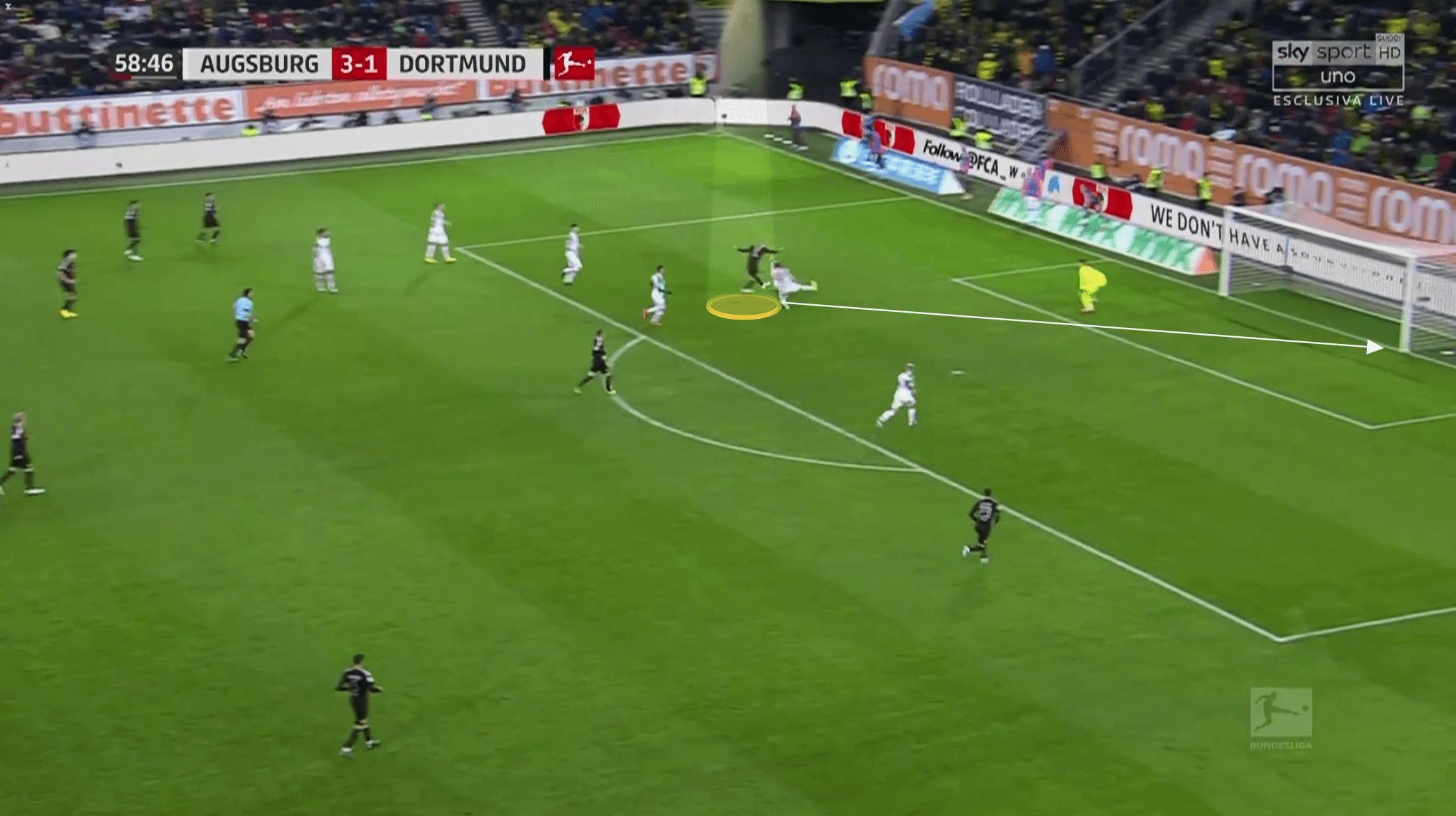
And in the other, he places it perfectly at the near post.
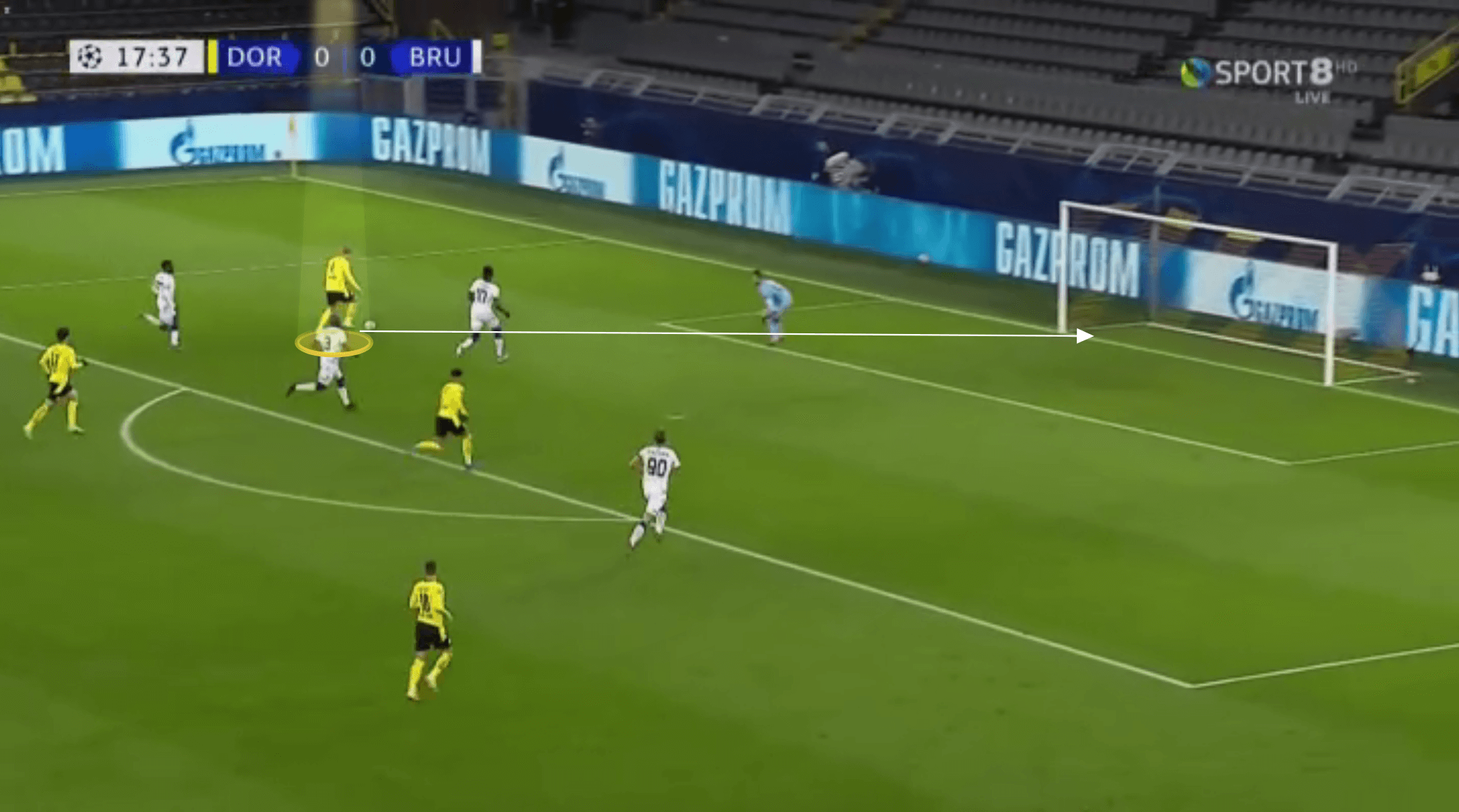
From this position, he has also hit them directly down the middle, above the keeper, and there are examples from the other side of the goal, where again he varies his decision.
We can see him going across the goal to the bottom corner in the first image in the top left.
Then going clockwise, he rounds the keeper, goes across the goal to the top corner, and finally goes front post to the top corner.
The positions these shots come from are very similar, and the keeper is in nearly identical in every image other than when Haaland decides to round him.
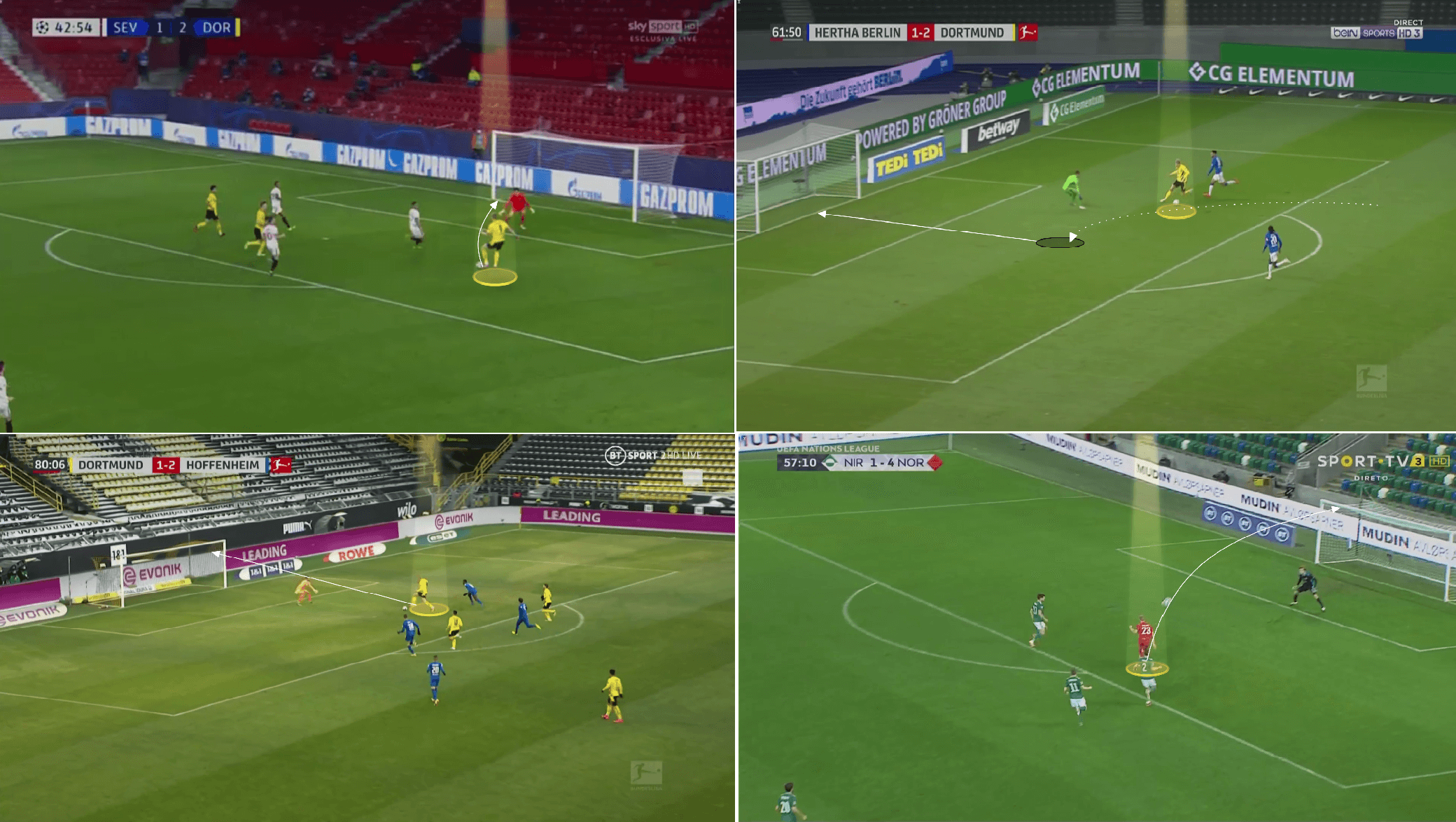
Erling Haaland Timing & anticipation
Haaland’s movement also stands out and whilst he is blessed to play with some elite creative talents like Jadon Sancho, his ability to hit the right area at the right time is key in creating chances for himself.
Upon immediately moving to Dortmund he found plenty of joy playing against high lines.
Haaland generally starts a little deeper, preferring not to immediately play on the shoulder of the last man, which we will see in more detail later on.
However, this position would allow him to hit top speed at the time of the through pass in behind.
He aims to be in line with the defensive line as the pass is played, whilst he is already sprinting, creating an advantage over the defenders.
His height was highlighted earlier, but Haaland’s pace makes playing a high line one of the more high-risk tactics.
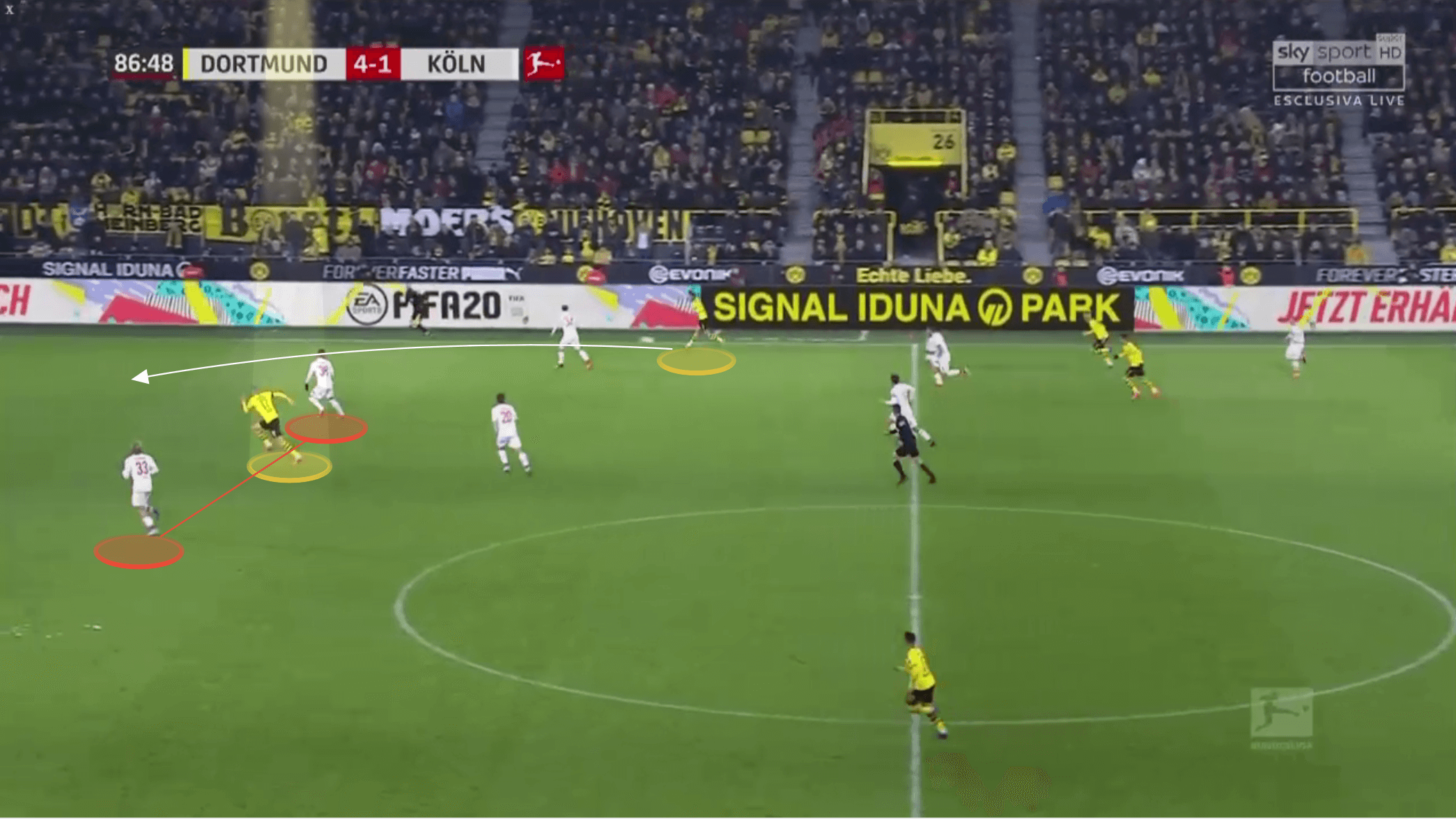
He still takes this position, even if the defence is set slightly deeper themselves.
Due to his speed, if the defence has their backs to their goal, and Haaland is facing it, he’s likely to get on the end of a through pass if it is weighted correctly.
We can see this from the Bayern game in the next set of images, where again Haaland isn’t touch-tight to the centre-backs.
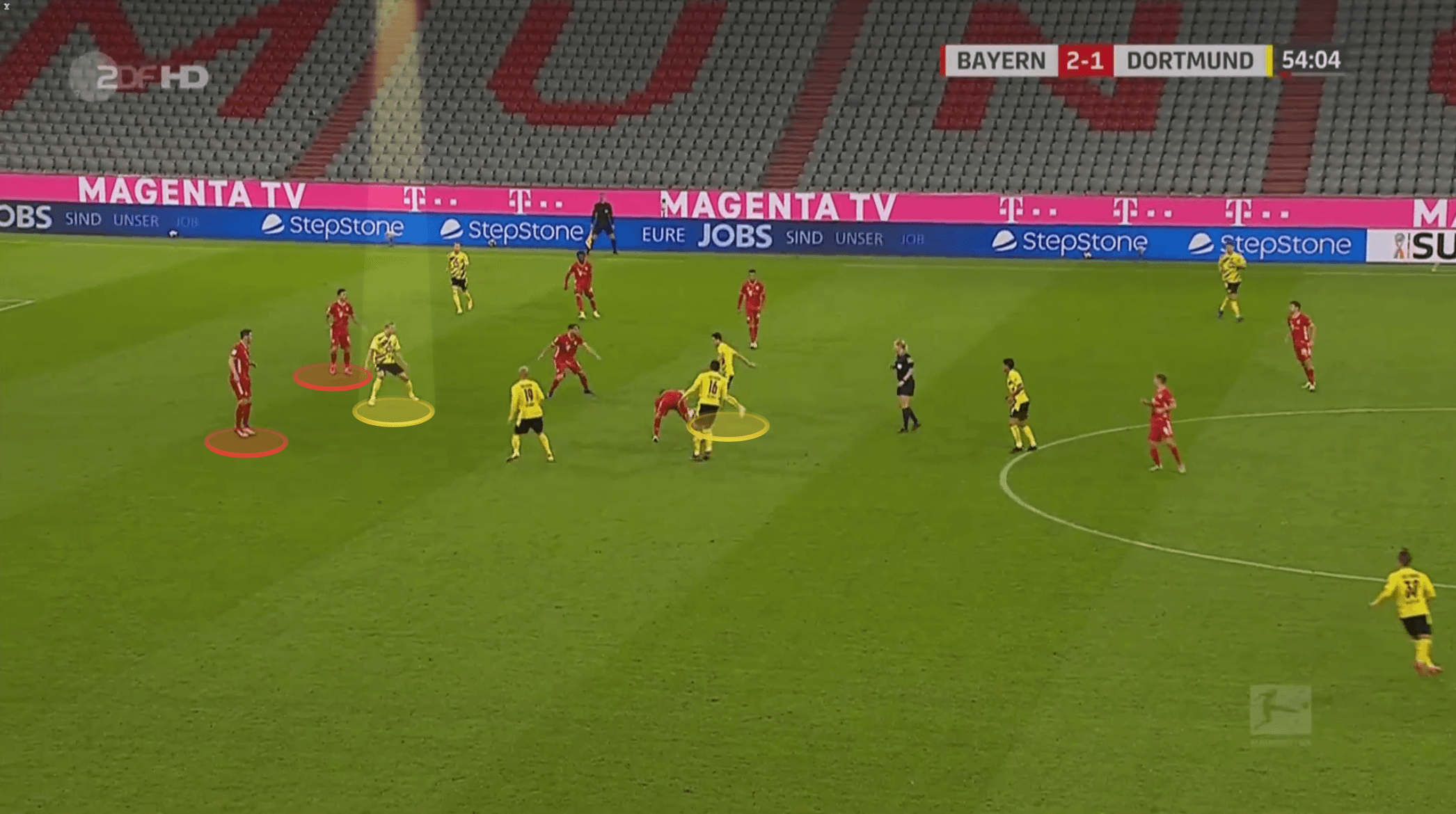
From this space, he is able to turn and make his run behind where defenders are going to struggle to keep up with him.
If he was touch-tight to the centre-backs they could either play him offside or anticipate the run more than they do in this example.
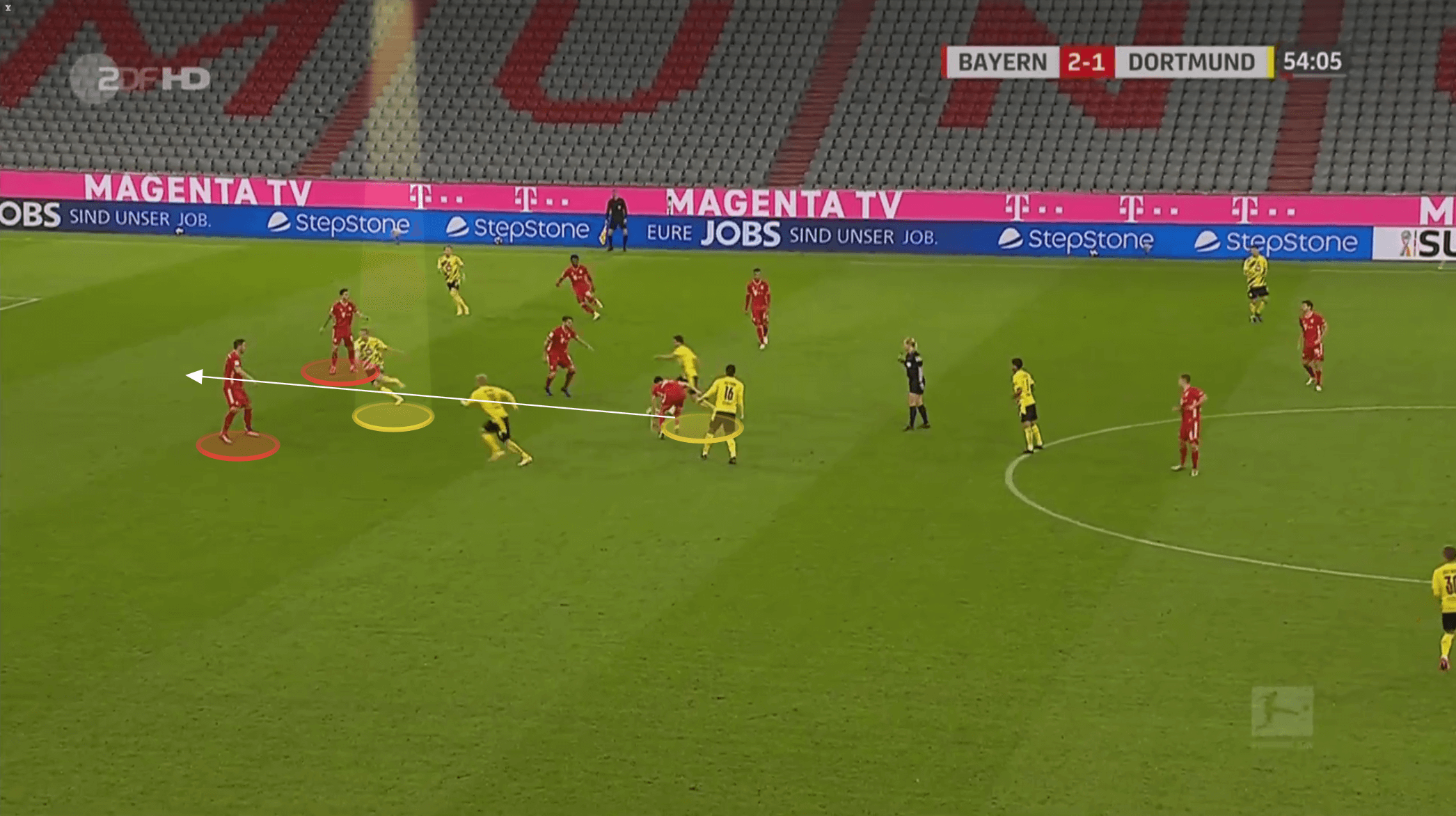
After his early burst of goals in the infancy of his Dortmund career, teams began to drop off and leave less space for through passes like the one above.
However, this isn’t to say every team sits deeper to prevent this pattern from occurring, but teams certainly seem to be playing a lower line than they were doing this time last year.
In regards to Haaland’s positioning, he aims to avoid being tightly marked for as long as possible, and will generally position himself between the two centre-backs, but slightly deeper.
When one of his wingers or full-backs has possession out wide, Haaland wants the ball-near centre-back to have to constantly look at the ball and then look at Haaland.
He doesn’t want the centre-back to be able to see both at the same time.
We can see that in the image below against Bayern where Jerome Boateng is having this exact issue.
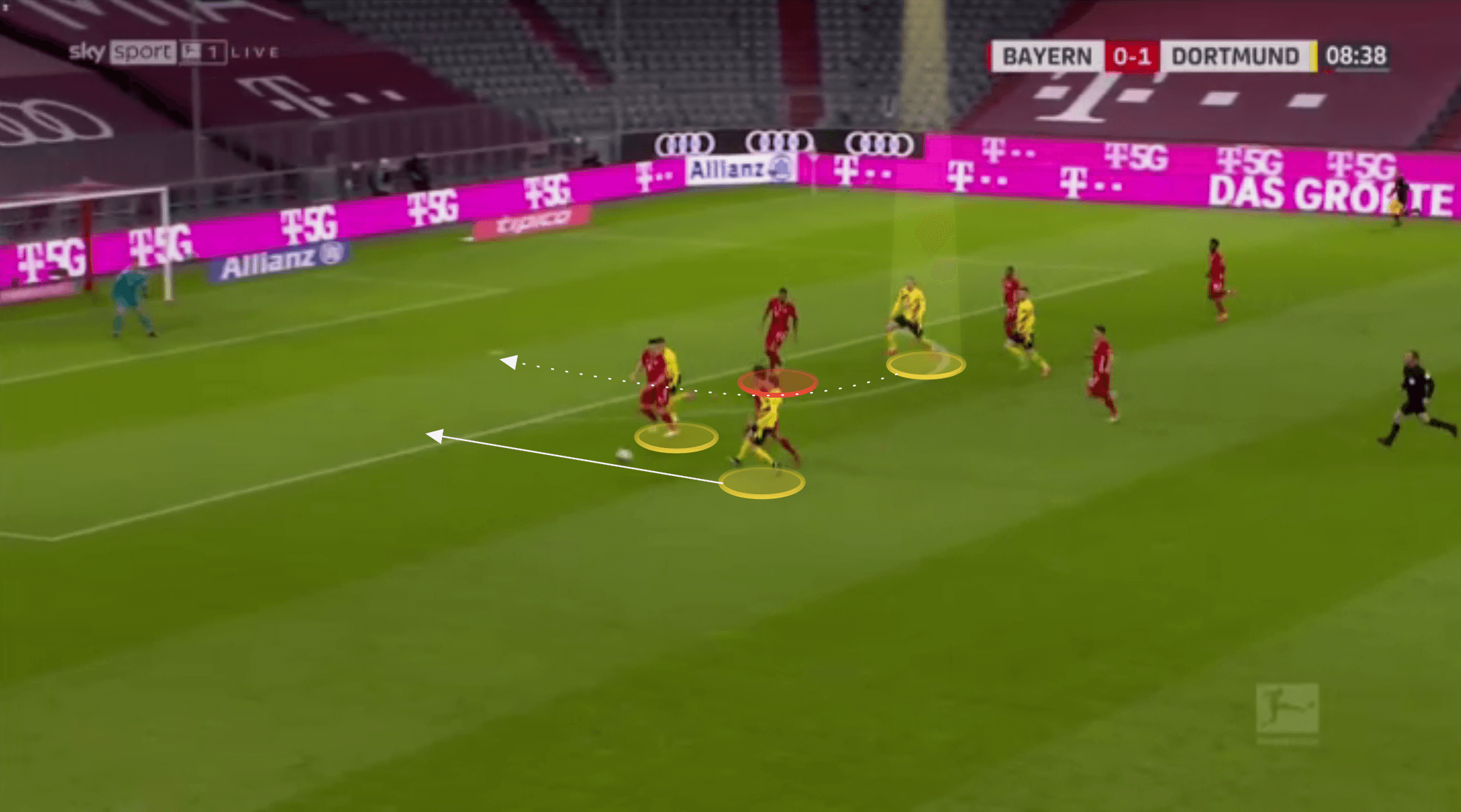
Haaland knows he is going to be quicker over 5-10 yards than most centre-backs, and this plays out in this example.
With Boateng unable to see exactly when Haaland is making his run, and with the centre-back having to look at the ball it’s difficult to know where the forward is running to.
In this example Haaland times his run to beat Boateng to the front post and tap the ball into the empty net.
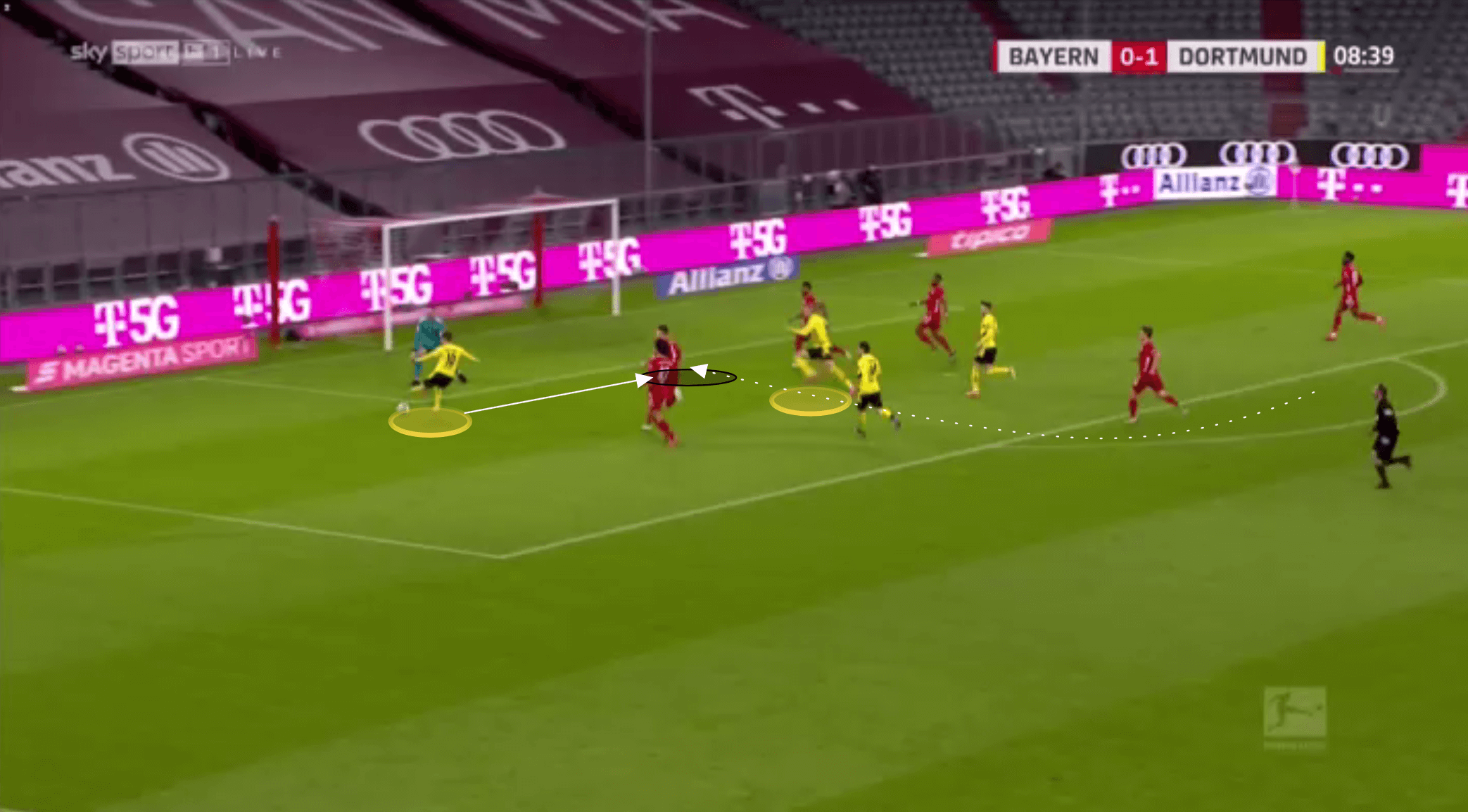
It sounds like such a cliche, but Haaland’s goalscoring instincts are so evident too.
Haaland regularly thinks a step ahead of those marking him.
No moment exemplifies this more than the goal against Koln from last season, shown below.
As Raphael Guerreiro takes the shot, we can already see Haaland timing his run, anticipating the goalkeeper parrying the shot.
The Koln defenders weren’t ready for this, and Haaland’s gamble paid off as the ball was spilt directly into his path, where he was able to finish with at least a yard of space between him and any defender.
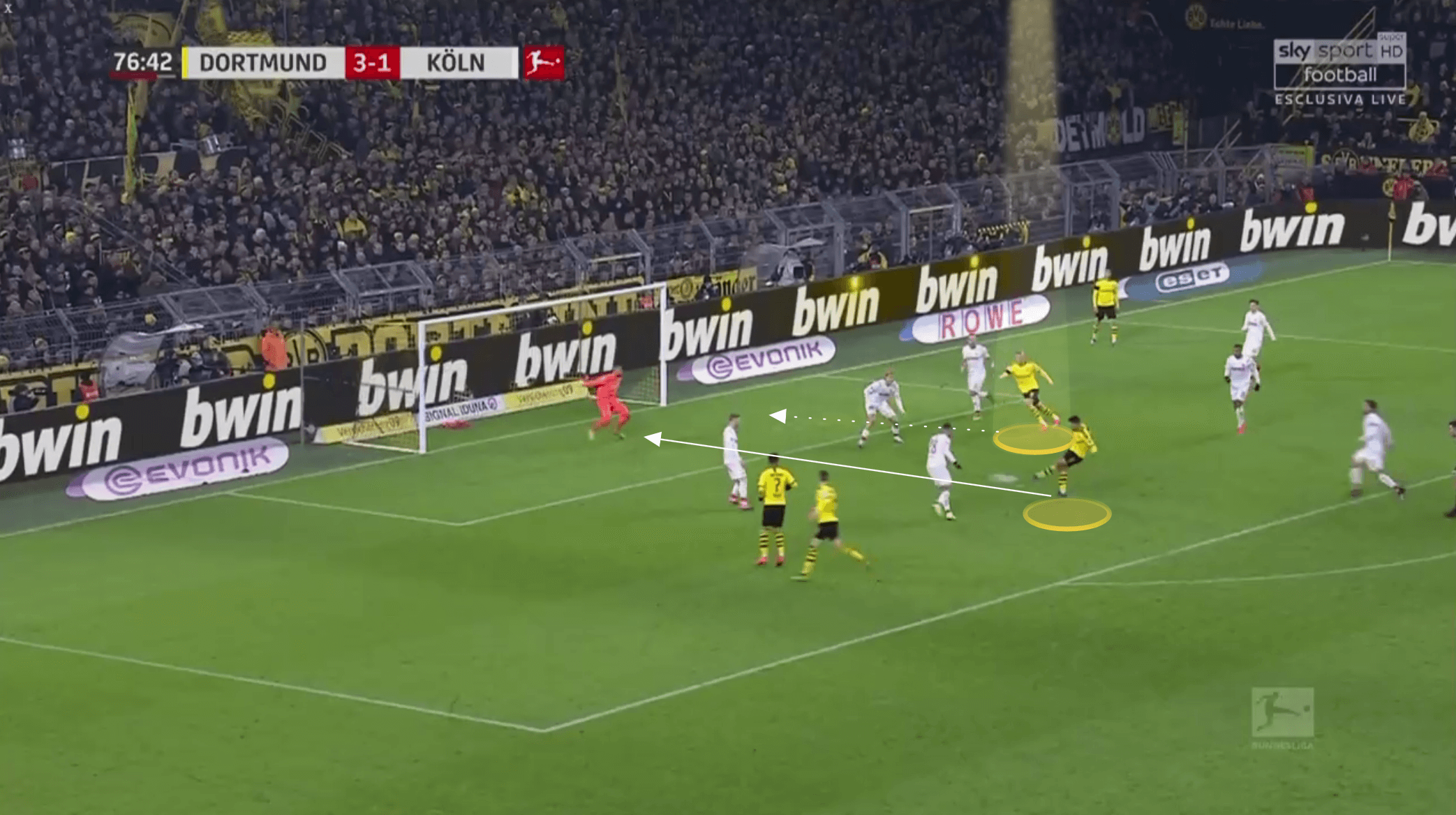
Erling Haaland Misdirection
Looking deeper at Haaland’s timing, we need to observe his use of misdirection.
In essence, this is when Haaland draws a defender away from an area he wants to hit.
It can be done in the box when looking to get on the end of crosses, or it can be done further away from goal, when looking to open up space for through passes.
Starting on the latter, we can see it as a good example against RB Leipzig.
With Haaland playing slightly off the last defender, it gives him more room to manoeuvre and allows him to dictate the positioning of the centre-back.
Again we see how the highlighted defender, Dayot Upamecano, has to keep looking at the ball but also Haaland.
If Haaland was touch-tight, Upamecano would have slightly more control over the situation, but with him drifting away from his man, Haaland has the upper hand.
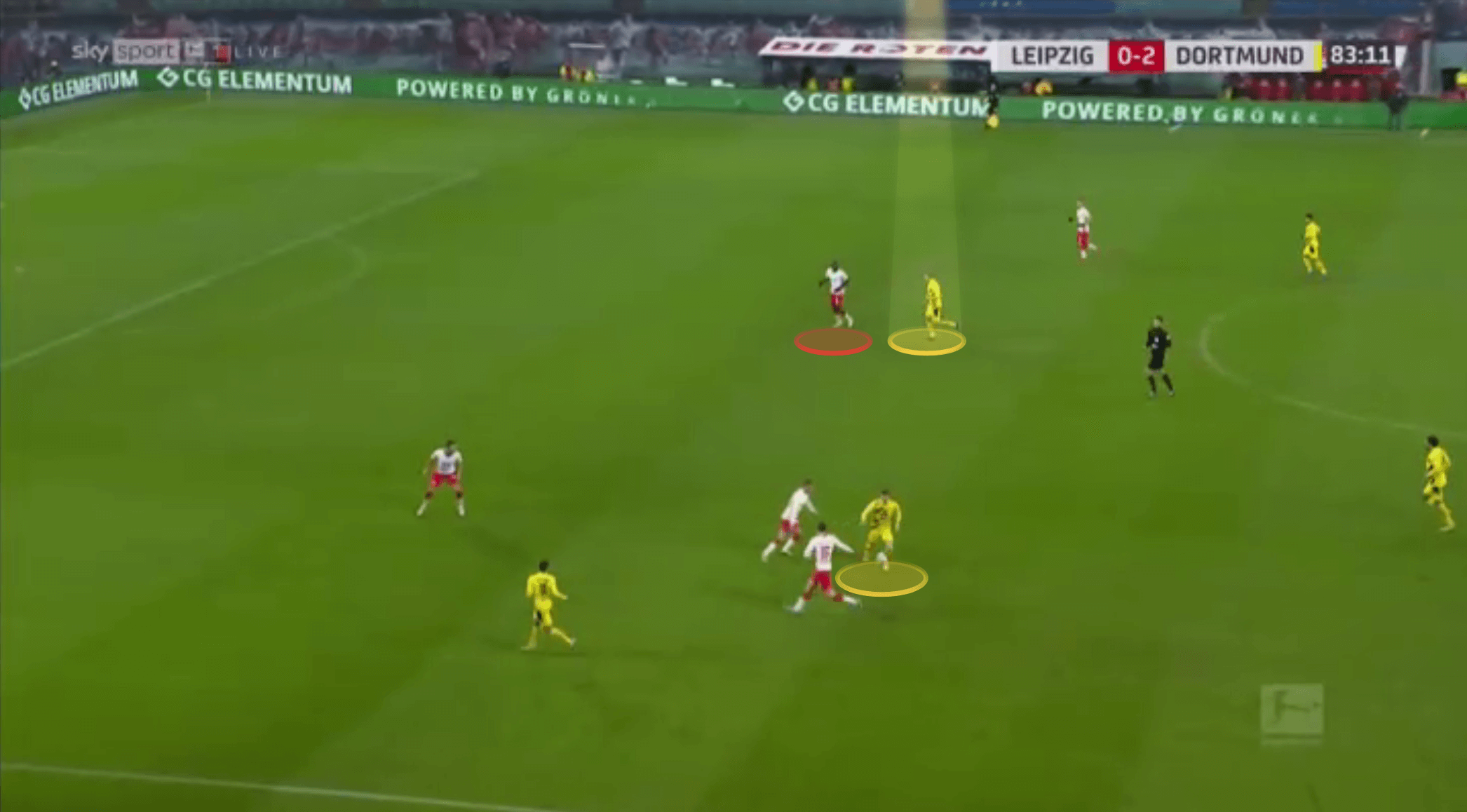
With Upamecano facing towards his goal, a through pass in the image below would lead to a foot race that the defender is well-positioned to deal with.
So Haaland drifts away from the ball.
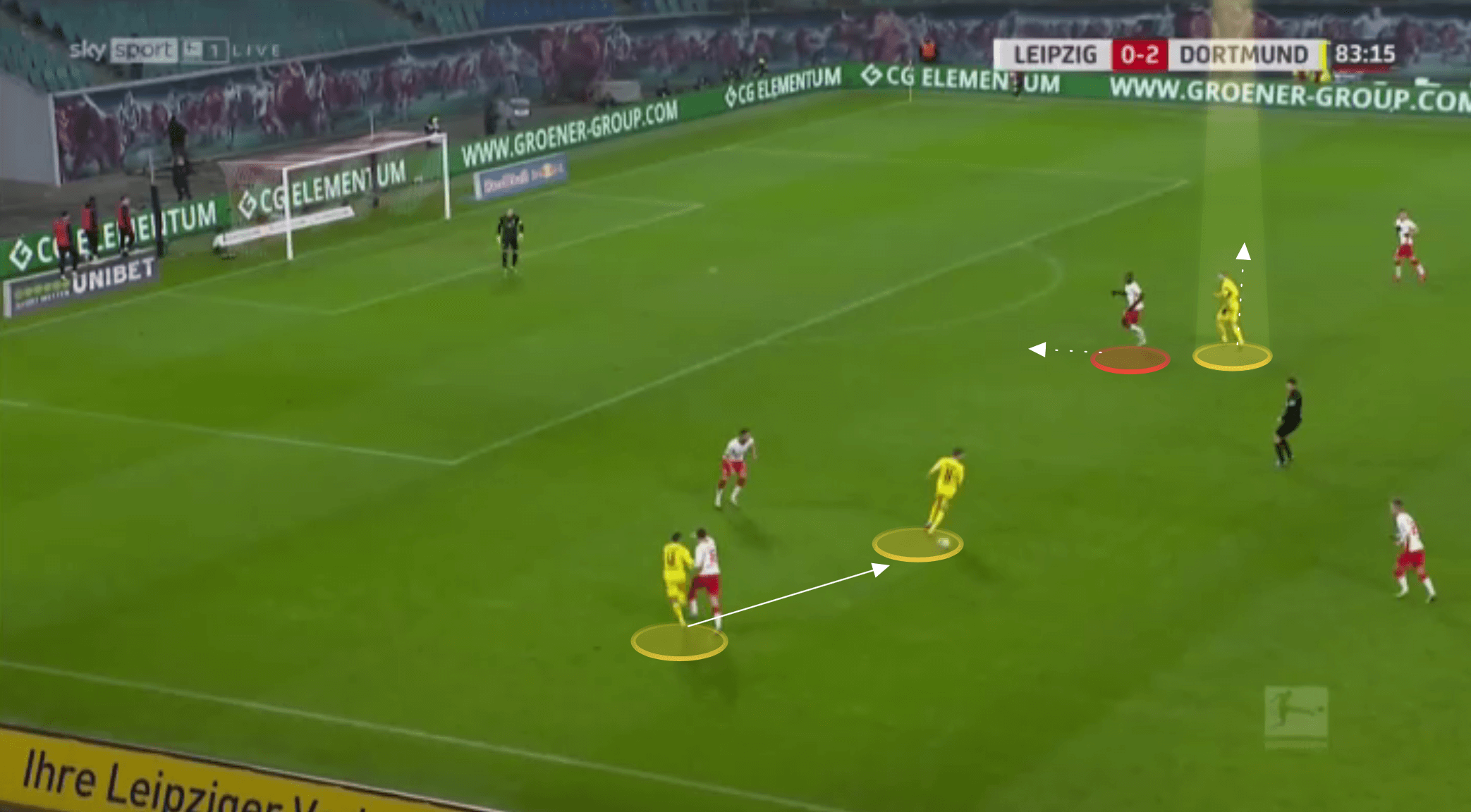
The defender is forced to open his body up, so he can see the ball and Haaland more easily.
We can see how Upamecano now has his back to goal, whereas Haaland is angled towards goal, giving the striker the upper hand when the ball is played in behind.
Haaland is ready to make his run, whilst Upamecano’s body position means he has to turn 180 degrees to react to the pass and he has created the space for the through pass.
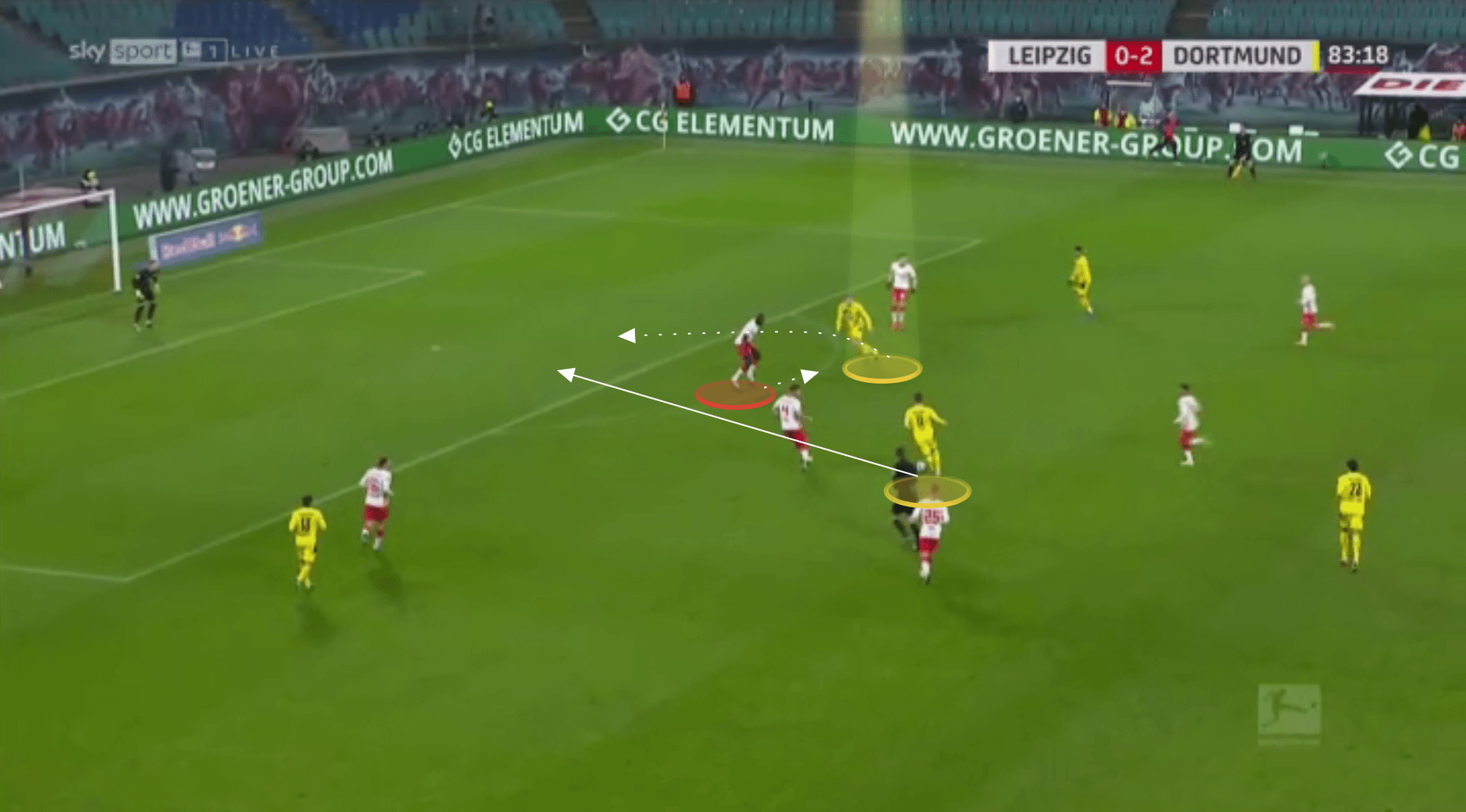
He does a phenomenal job at stealing in behind defenders in the box, timing his move to perfection where he can tap home unopposed, from a matter of yards out.
Whereas when he looks to make the run to the front post, Haaland’s run in these circumstances is aimed towards the back post.
As a result, he prefers to position himself on the shoulder of the far-side centre-back.
Again this incorporates the same principle as before, where he wants the defender having to watch both the ball, and then Haaland, but not being able to do so at the same time.
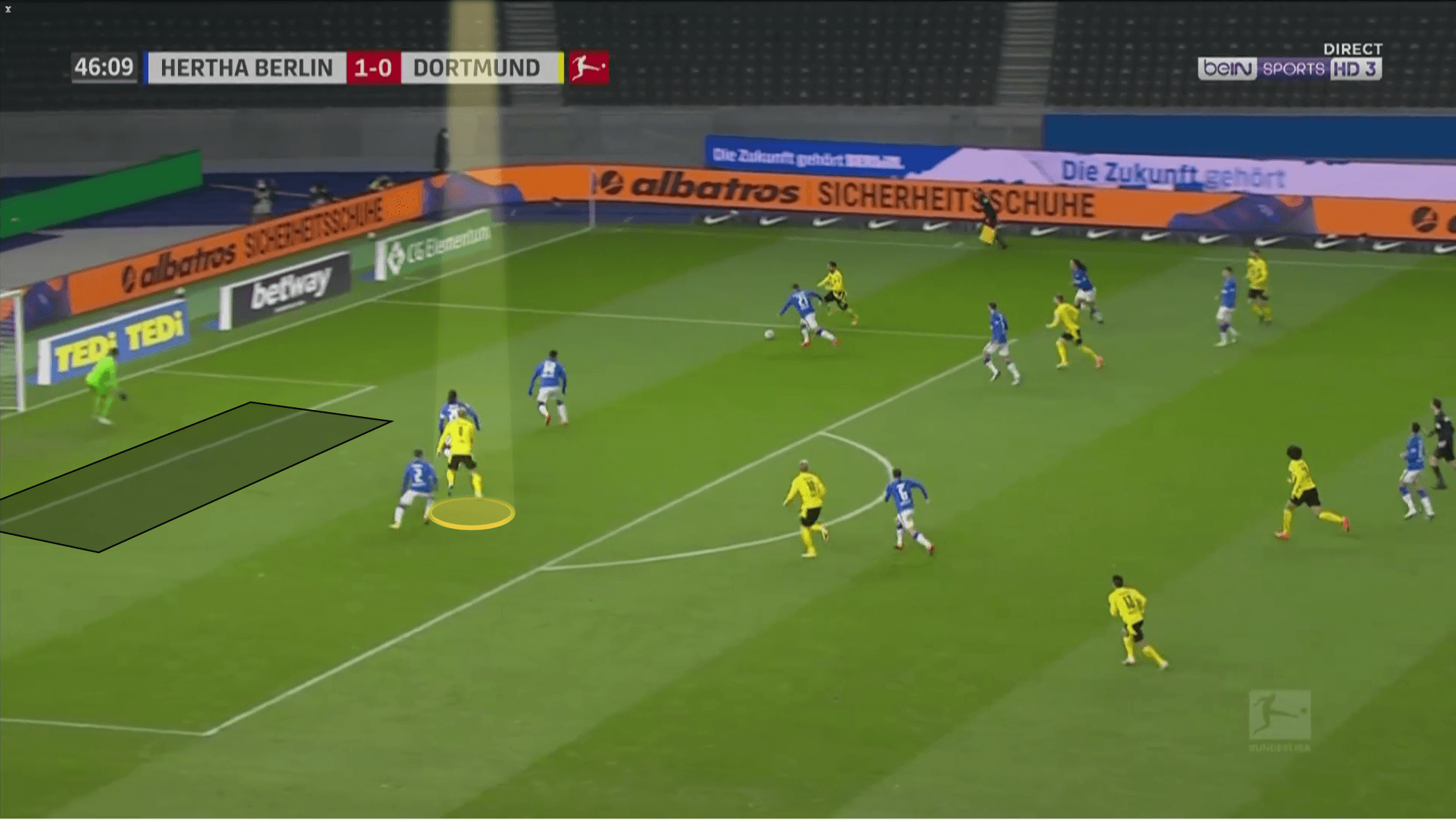
We can see how much space he can create for himself with this simple run in behind from looking at these two images of Dortmund’s first goal against Hertha Berlin.
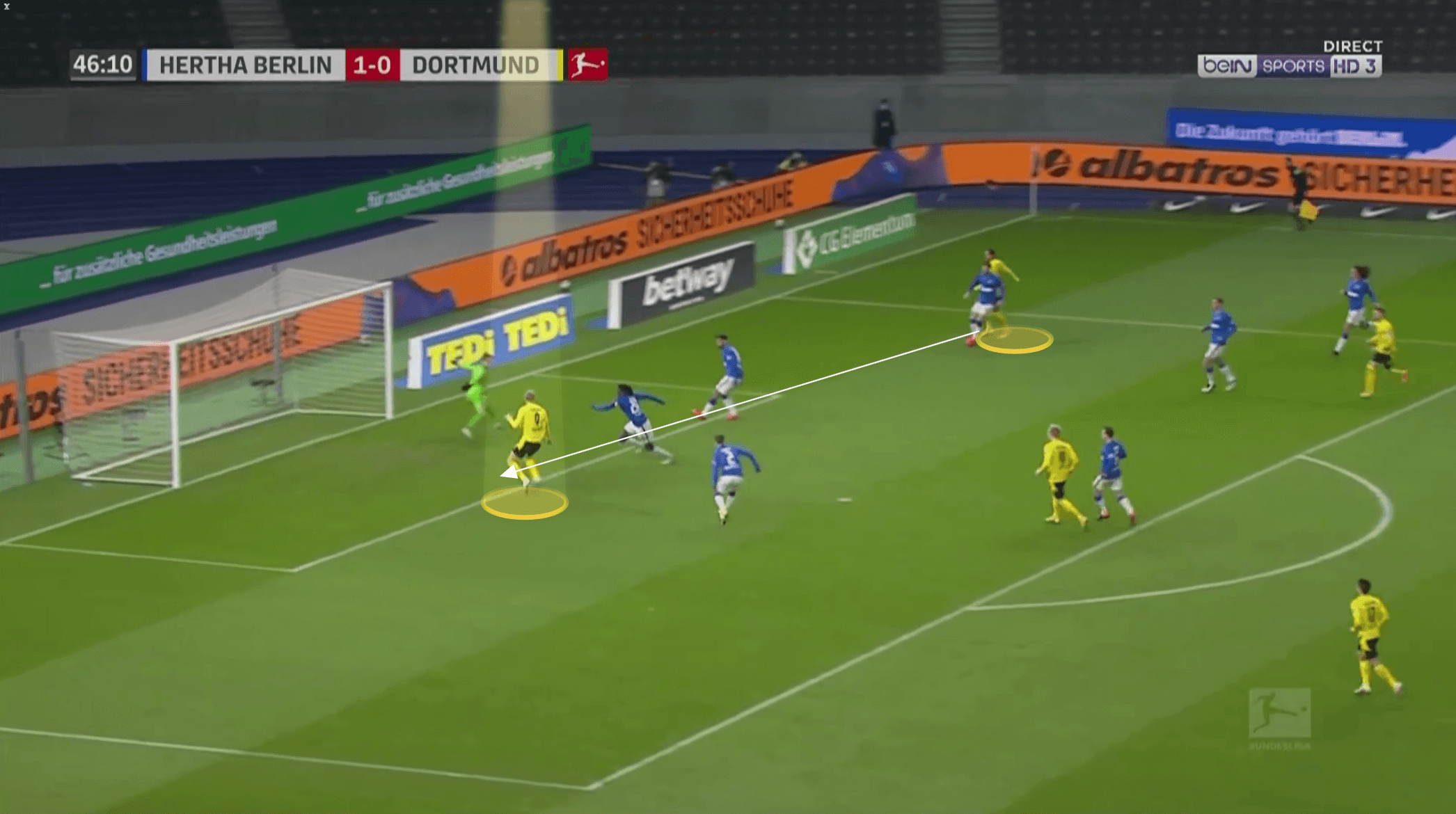
It isn’t always this easy though, and if he’s marked more closely, Haaland creates space for himself with a simple use of misdirection.
Against Schalke, he initially darted towards the front post to take the centre-back in that direction.
Haaland even put his arm on the shoulder of the defender to give a slight push-off – something we sometimes see from basketball players when dribbling as they look to send the defender in the wrong direction and create more space for themselves in a quick change of direction (called a crossover).
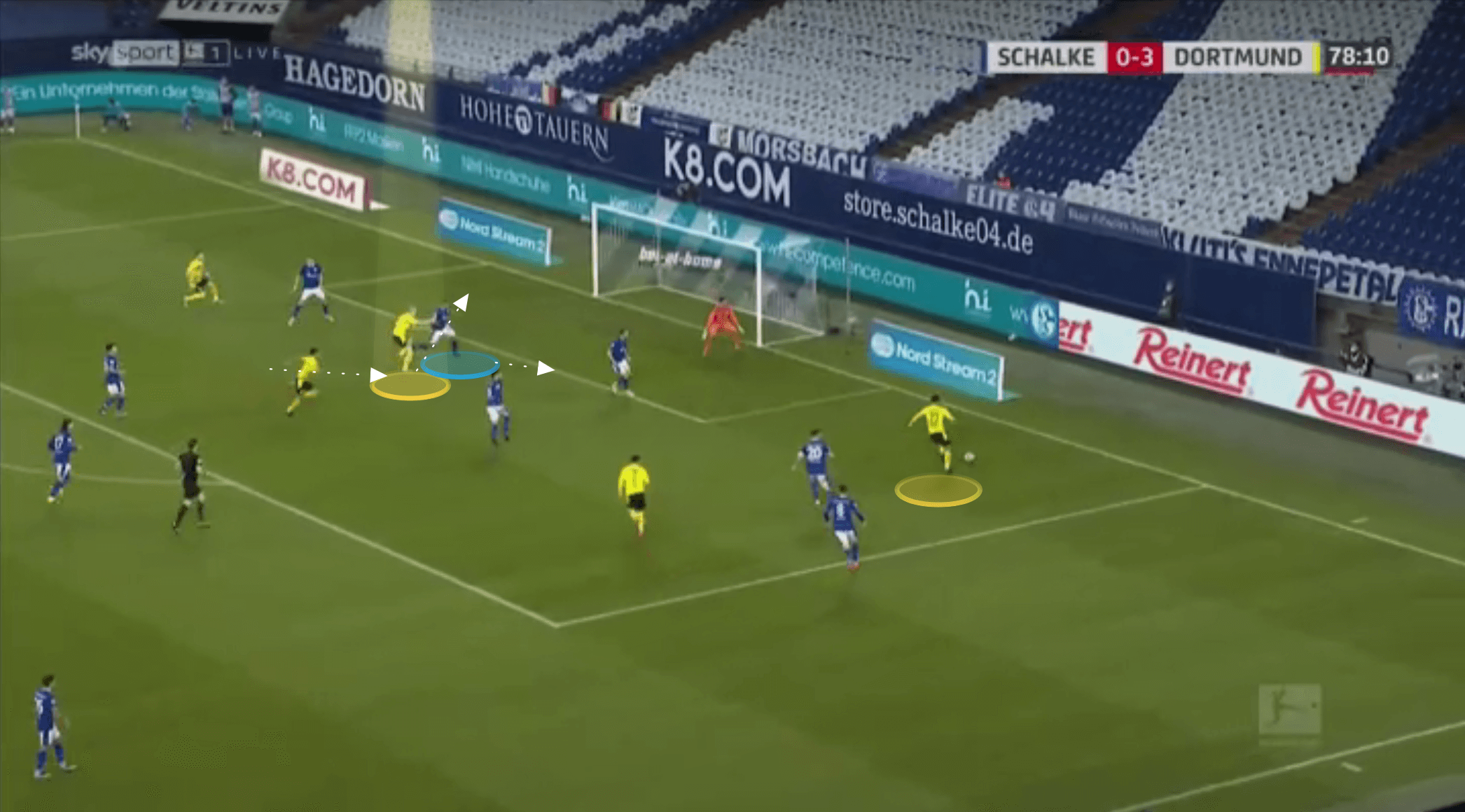
He then makes that quick shift in direction towards the back post, where he can tap home once more.
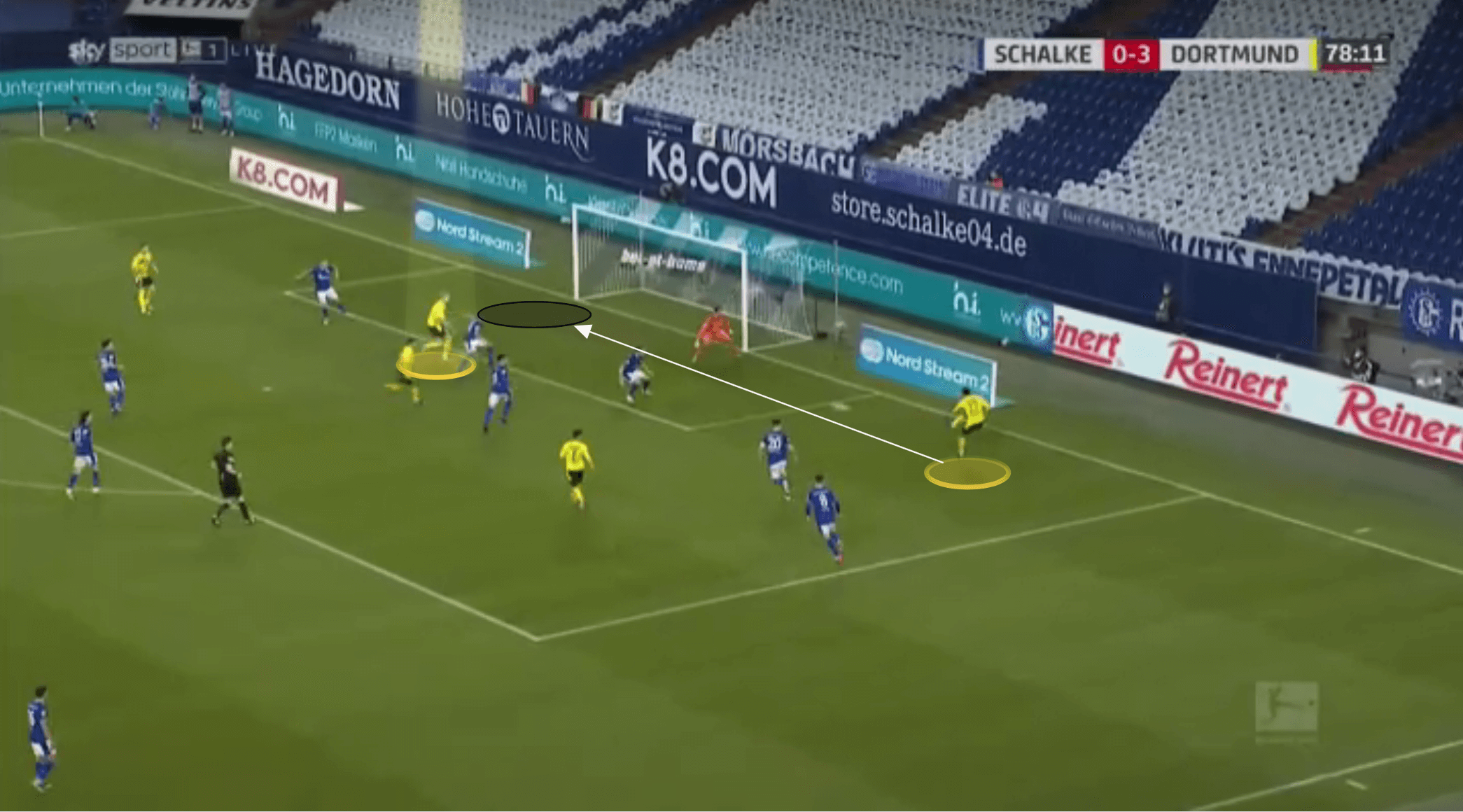
He uses this misdirection when making runs towards the front post too.
These are most often seen on a fast break when the defence isn’t set.
In the recent second-leg Champions League fixture, Haaland notched his first of the game with that late run towards the front post.
We can once again note how he starts between the two centre-backs, not playing on the last man.
He looks to initially move toward the far-side centre-back, to create more space for himself before he makes the run.
He then darts towards the front post, creating an overload on the ball near centre-back.
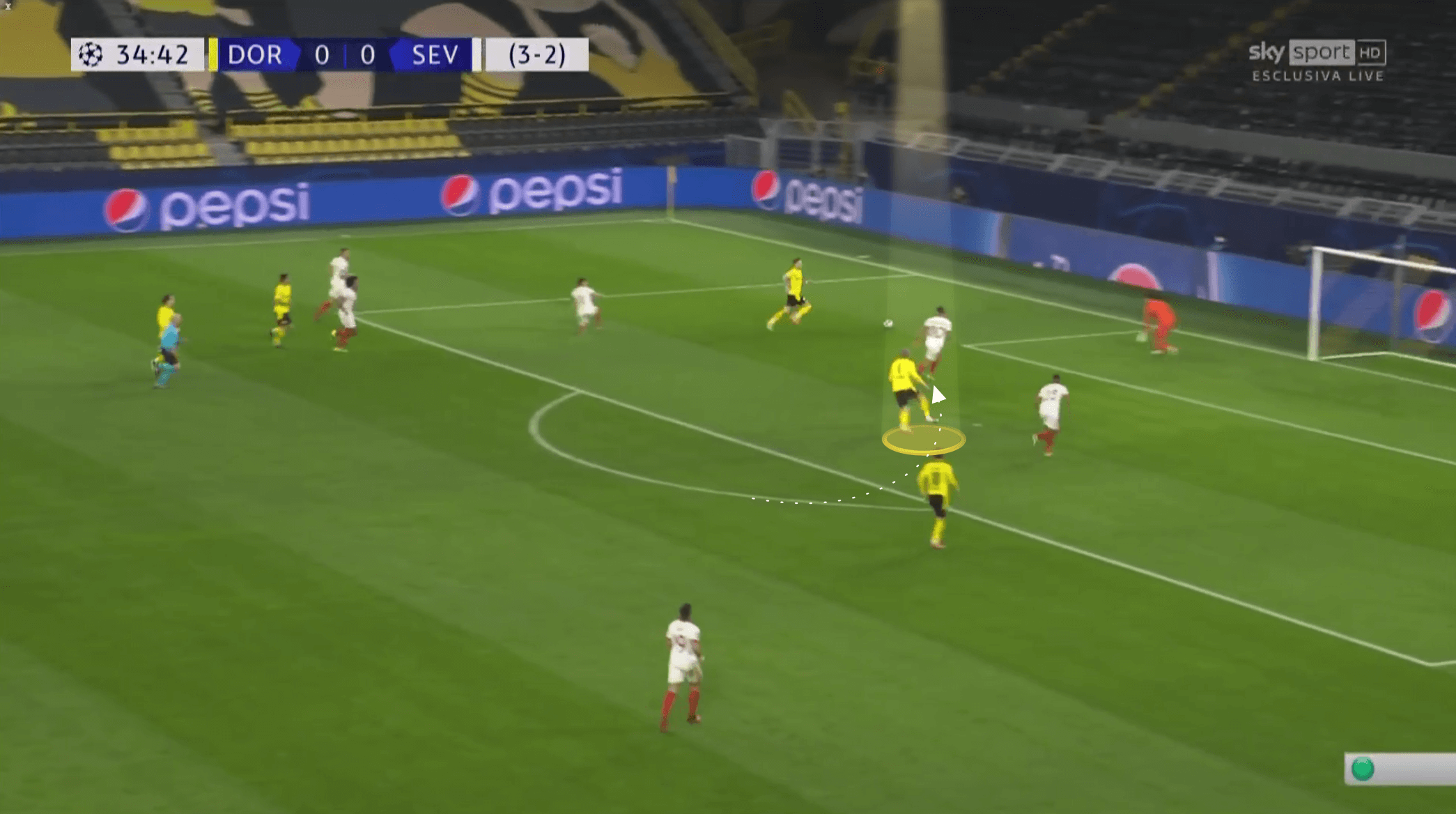
Haaland observed that the highlighted Sevilla defender was anticipating the ball across goal into the six-yard box and adjusted his run to receive just ahead of the penalty spot.
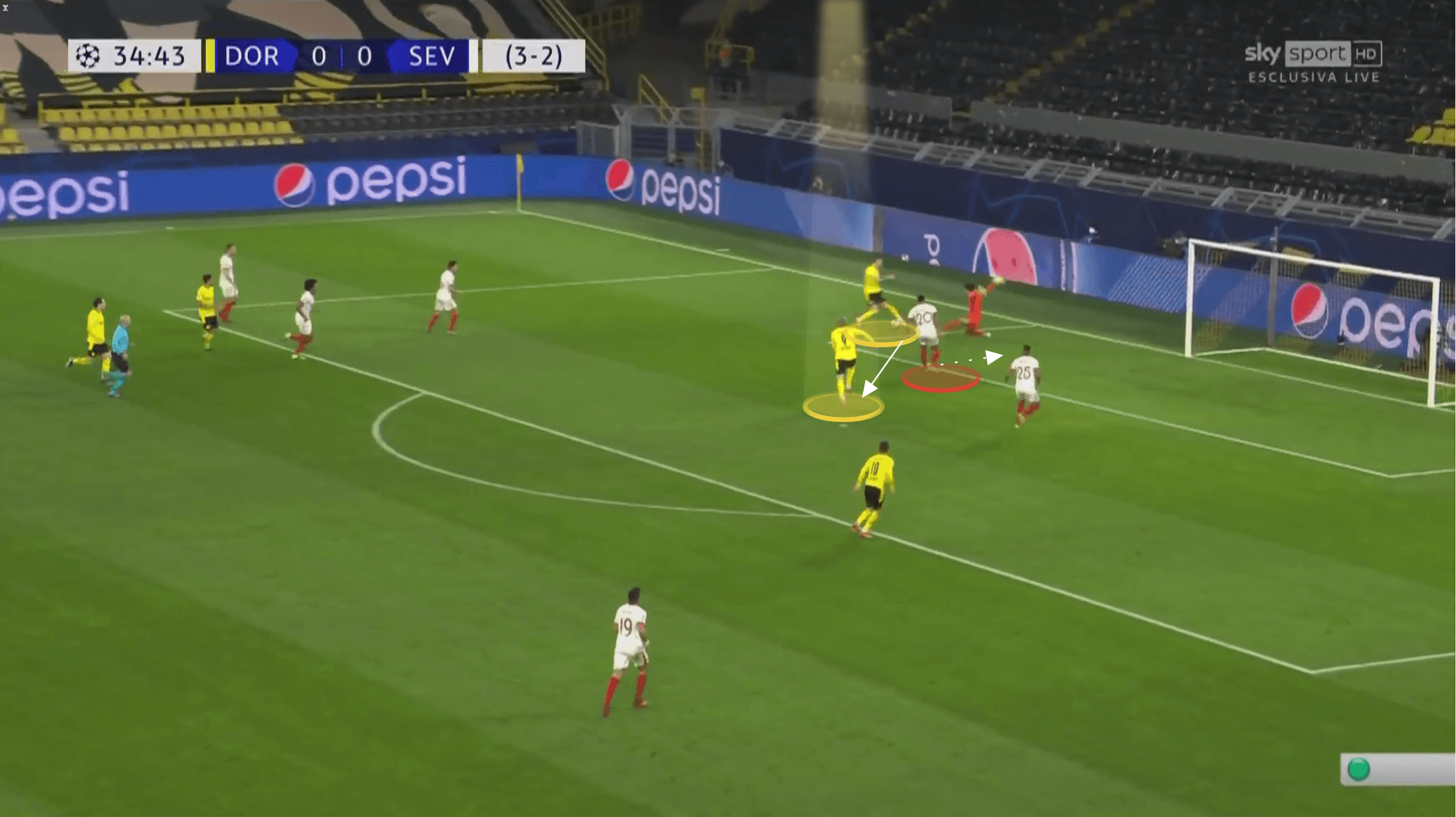
Even when the defender is aware of him making this run, like below, they’re unable to watch him and the ball at the same time.
With Haaland arriving with such pace to latch onto the pull-back, it makes it so hard to defend this run.
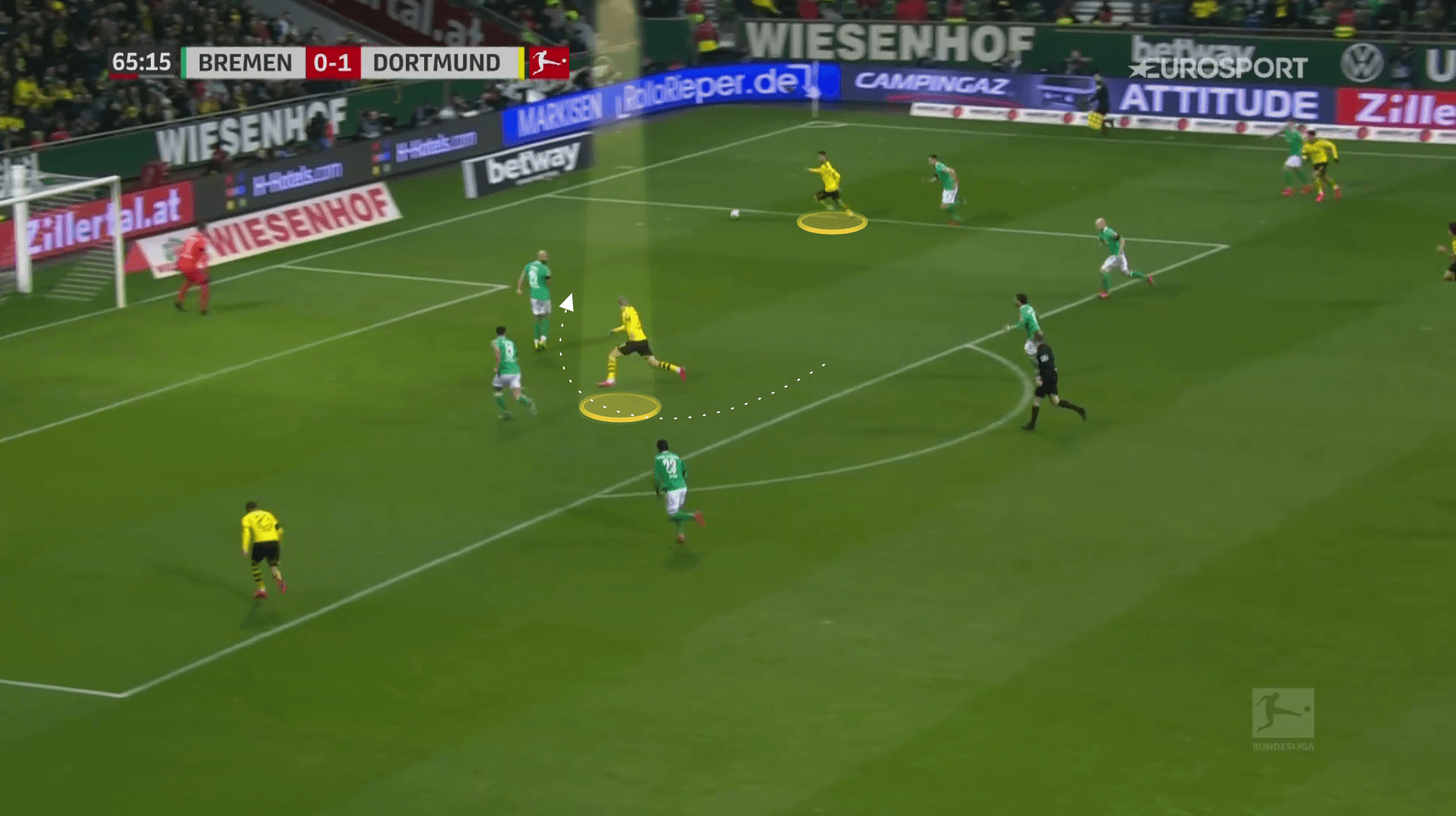
Conclusion
It is a culmination of his finishing ability, his movement, his timing and instinct, and his pace, strength and height that make Haaland an incredibly well-rounded forward.
There aren’t many forwards to have graced the game who have possessed such a wide range of abilities, let alone who have demonstrated them so consistently at such a young age.
Haaland style of play will continue to grow as a player and likely add even more to what is already such an outstanding all-round game.
However, this Eerling Haaland analysis has aimed to merely highlight some of the things he is currently doing so well that have led to him being one of the most prolific forwards in world football.





Comments